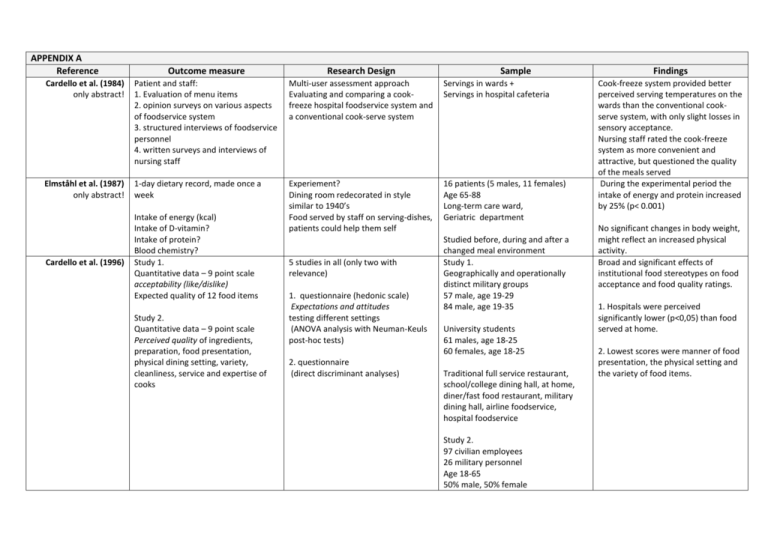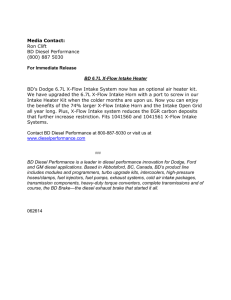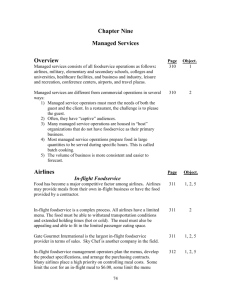APPENDIX A Reference Outcome measure Research Design
advertisement

APPENDIX A Reference Outcome measure Research Design Cardello et al. (1984) only abstract! Patient and staff: 1. Evaluation of menu items 2. opinion surveys on various aspects of foodservice system 3. structured interviews of foodservice personnel 4. written surveys and interviews of nursing staff Multi-user assessment approach Evaluating and comparing a cookfreeze hospital foodservice system and a conventional cook-serve system Servings in wards + Servings in hospital cafeteria Elmståhl et al. (1987) only abstract! 1-day dietary record, made once a week Experiement? Dining room redecorated in style similar to 1940’s Food served by staff on serving-dishes, patients could help them self 16 patients (5 males, 11 females) Age 65-88 Long-term care ward, Geriatric department Cardello et al. (1996) Intake of energy (kcal) Intake of D-vitamin? Intake of protein? Blood chemistry? Study 1. Quantitative data – 9 point scale acceptability (like/dislike) Expected quality of 12 food items Study 2. Quantitative data – 9 point scale Perceived quality of ingredients, preparation, food presentation, physical dining setting, variety, cleanliness, service and expertise of cooks 5 studies in all (only two with relevance) 1. questionnaire (hedonic scale) Expectations and attitudes testing different settings (ANOVA analysis with Neuman-Keuls post-hoc tests) 2. questionnaire (direct discriminant analyses) Sample Studied before, during and after a changed meal environment Study 1. Geographically and operationally distinct military groups 57 male, age 19-29 84 male, age 19-35 University students 61 males, age 18-25 60 females, age 18-25 Traditional full service restaurant, school/college dining hall, at home, diner/fast food restaurant, military dining hall, airline foodservice, hospital foodservice Study 2. 97 civilian employees 26 military personnel Age 18-65 50% male, 50% female Findings Cook-freeze system provided better perceived serving temperatures on the wards than the conventional cookserve system, with only slight losses in sensory acceptance. Nursing staff rated the cook-freeze system as more convenient and attractive, but questioned the quality of the meals served During the experimental period the intake of energy and protein increased by 25% (p< 0.001) No significant changes in body weight, might reflect an increased physical activity. Broad and significant effects of institutional food stereotypes on food acceptance and food quality ratings. 1. Hospitals were perceived significantly lower (p<0,05) than food served at home. 2. Lowest scores were manner of food presentation, the physical setting and the variety of food items. Holm & Smidt (1997) Holm & Jacobsen (1990) Study a, Questionnaires (predetermined response categories) Opinions about the food and food system (satisfaction) Study b, Interviews (semi-structured, thematic – open and in-depth) Personal experience and considerations On quality of life 3 methods ‘triangulation’ Evaluation study combining quantitative survey method with qualitative interviews and observation Study evaluating the impact of the introduction of a new food system in a hospital ward for children with cancer food intake? Dietary data (energy intake) Evening (kcal) Midday (kcal) Breakfast (kcal) Hartwell et al. (2006) Patient satisfaction Meal experience Study a 91 children, age > 12 83 parents 75 staff In hospital ward From a centralized food production system to locally staffed kitchen built in the middle of the ward Study c observations (unstructured, nonparticipant, overt) physical environment and social interaction around meals Edwards & Hartwell (2004) Malnutritioned children with cancer Rigshospitalet, DK A small pilot study. Data collected for 3 consecutive 24 h periods from patients who consumed meals either in bed, at side of bed or in presence of others. Food items weighed using Hanson Digital scales. Nutritional analysis using Microdiet software program. Statistical analysis using SPSS. Focus groups + Open-end interviews. NHS hospital, UK. Bulk Trolley Foodservice System Purposive sampling Data collected until saturation point Study b 12 children, age 6-18 12 parents 10 staffmembers At ward or at childrens home 1-2 h, and youngest ½h Study c 1 week in ward rooms and corridors/ meal situations in kitchen-dining rooms (4 meals) n = 13 (in all) n=4 (at table) n=5 (at bed) n=4 (in bed) post-operative patients ambulant age 36-62 Womens’s Health Unit , NHS hospital, UK. Pre-ordered meals, plated in kitchen and placed onto patient trays n=4 (doctors) n=5 (nurses) n=3 (ward hostesses) n= 10 (patients +visitors) foodservice manager, facilities Severe status differences between patients and staff. For patients and parents food was a central part of their quality of life while hospitalized. For staff food was a area of low status. In the traditional food system mean energy intake was 49%, new system increased the mean energy intake to 70% of recommended intake Significant increase (p<0.05) found in the mean daily energy intake for those sitting around table in the presence of others (especially at midday meal) However, no significant difference in evening meals and only difference between table and by bed at breakfast Food qualities, particularly temperature and texture are important factors impinging on patient satisfaction, and the trolley system of delivery is an acceptable style of service Hartwell et al. (2007) Focus groups in ward (½ h) Open-end interviews in respondent’s office (½ h) Interviews transcribed, text analysis using NUD*IST, a computer-assisted qualitative data analysis software package together with researcher own knowledge and understanding Bulk trolley foodservice system versus plate delivery foodservice system. Quality indicators of food (used to measure patient satisfaction) Comparision between service style and food attribute was tested with the Mann-Whitney U test. Binary logistic regression analysis (to build model predicting food service style). Multinomial logistic regression (to predict opinion for the assessment of each food attribute) manager, chief dietitian, orthopaedic ward dietitian, chief pharmacist Relationships between patients’ intake and the number of interpersonal exchanges with mealtime fellows (aagency and communication dimensions) Observation on repeated mealtime occasions Experience sampling methods or ecological momentary assessment techniques n=1477 32 geriatric patients 21 female 11 male Mean age 78,8 The nature of behaviors expressed (verbal/ non-verbal) Multilevel regression analyses Rehabilitation unit in geriatric facility, Canada. Meals consumed in common dining area with 24 diners 6 tables, eating in company of 2-3 fellow patients 3 meals a day, every day until discharge (max 6 weeks) Patient satisfaction via consumer opinion card with 7point rating scales + space for openended comments Five attributes of the food was rated; temperature, texture, flavor, portion size, respondents’s overall opinion of the food Paquet et al. (2008) The degree of complementarity Food intake (visual estimation of portion, using 5-point Comstock scale) Meal duration Use of interpersonal circumplex model in observation to evaluate how specific elements of the meal social environment contribute to the social facilitation Orthopaedic ward Males and females Patients age 66-84 Patients length of stay > 7 days n=180 orthopaedic wards 1 month period 59 female 41 male Age 20-80 Length of stay 1 day to 1 week Service predisposition demonstrates little relevance to patient satisfaction towards overall meal enjoyment Bulk trolley enables food to have more acceptable texture, temperature and flavor then plate delivery system NHS Hospital, UK where a plated system was in place, and a bulk trolley system to be introduced The total amount of interaction between patients was positively related to intake The effect was significant for both participants’ own behaviors and those to which they were exposed






